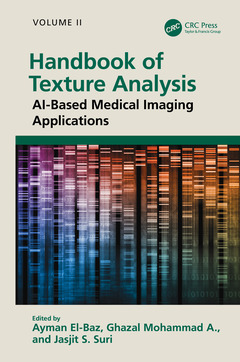Handbook of Texture Analysis AI-Based Medical Imaging Applications
Coordonnateurs : El-Baz Ayman, Ghazal Mohammed, Suri Jasjit S.

The major goals of texture research in computer vision are to understand, model, and process texture and, ultimately, to simulate the human visual learning process using computer technologies. In the last decade, artificial intelligence has been revolutionized by machine learning and big data approaches, outperforming human prediction on a wide range of problems. In particular, deep learning convolutional neural networks (CNNs) are particularly well suited to texture analysis. This volume presents important branches of texture analysis methods which find a proper application in AI-based medical image analysis. This book:
- Discusses first-order, second-order statistical methods, local binary pattern (LBP) methods, and filter bank-based methods
- Covers spatial frequency-based methods, Fourier analysis, Markov random fields, Gabor filters, and Hough transformation
- Describes advanced textural methods based on DL as well as BD and advanced applications of texture to medial image segmentation
- Is aimed at researchers, academics, and advanced students in biomedical engineering, image analysis, cognitive science, and computer science and engineering
This is an essential reference for those looking to advance their understanding in this applied and emergent field.
1 An Exploratory Review on Local Binary Descriptors for Texture Classification 2 Precision Grading of Glioma: A System for Accurate Diagnosis and Treatment Planning 3 Enhancing Accuracy in Liver Tumor Detection and Grading: A Computer-Aided Diagnostic System 4 Texture Analysis in Radiology 5 Texture Analysis Using a Self-Organizing Feature Map 6 Sensor-Based Human Activity Recognition Analysis Using Machine Learning and Topological Data Analysis (TDA) 7 Application of Texture Analysis in Retinal OCT Imaging 8 Automation in Pneumonia Detection
9 Texture for Neuroimaging 10 A Multimodal MR-Based CAD System for Precise Assessment of Prostatic Adenocarcinoma 11 Texture Analysis in Cancer Prognosis
Ayman El-Baz is a Distinguished Professor at University of Louisville, Kentucky, United States and University of Louisville at Alamein International University (UofL-AIU), New Alamein City, Egypt. Dr. El-Baz earned his B.Sc. and M.Sc. degrees in electrical engineering in 1997 and 2001, respectively. He earned his Ph.D. in electrical engineering from the University of Louisville in 2006. Dr. El-Baz was named as a Fellow for IEEE, Coulter, AIMBE and NAI for his contributions to the field of biomedical translational research. Dr. El-Baz has almost two decades of hands-on experience in the fields of bio-imaging modeling and non-invasive computer-assisted diagnosis systems. He has authored or coauthored more than 700 technical articles.
Mohammed Ghazal is a Professor and Chairman of the Department of Electrical, Computer, and Biomedical Engineering at the College of Engineering, Abu Dhabi University, UAE. His research areas are bioengineering, image and video processing, and smart systems. He received his Ph.D and M.A.Sc in Electrical and Computer Engineering (ECE) from Concordia University in Montreal Canada in 2010 and 2006, respectively, and his B.Sc. in Computer Engineering from the American University of Sharjah (AUS) in 2004. He has received multiple awards including the Distinguished Faculty Award of Abu Dhabi University in 2017 and 2014. Dr. Ghazal has authored or co-authored over 70 publications in recognized international journals and conferences including IEEE Transactions in Image Processing, IEEE Transactions in Circuits and Systems for Video Technology, IEEE Transactions in Consumer Electronics, Elsevier's Renewable Energy Reviews, and Springer's Multimedia Tools and Applications.
Jasjit S. Suri is an innovator, scientist, visionary, industrialist and an internationally known world leader in biomedical engineering. Dr. Suri has spent over 25 years in the field of biomedical engineering/devices and its management. He rece
Date de parution : 06-2024
15.6x23.4 cm
Thèmes de Handbook of Texture Analysis :
Mots-clés :
image processing; biomedical imaging; biomedical image processing; first-order statistical methods; second-order statistical methods; local binary pattern (LBP) methods; filter bank based methods; spatial-frequency based methods; Fourier analysis; Markov random fields; Gabor filters; Hough transformation


